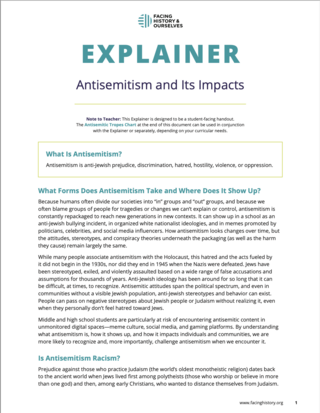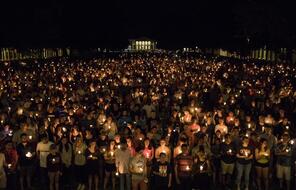Antisemitism and Its Impacts
At a Glance
Language
English — USSubject
- History
- Social Studies
- Antisemitism

Antisemitism and Its Impacts
Download a PDF of this Explainer and Tropes Chart
Note to Teacher: This Explainer is designed to be a student-facing handout. The Antisemitic Tropes Chart can be used in conjunction with the Explainer or separately, depending on your curricular needs. However, please do not print out and distribute the Antisemitic Tropes Chart or give students unmonitored access to it, as it contains images and language that could cause harm out of this specific context.
What Is Antisemitism?
Antisemitism is anti-Jewish prejudice, discrimination, hatred, hostility, violence, or oppression.
What Forms Does Antisemitism Take and Where Does It Show Up?
Because humans often divide our societies into “in” groups and “out” groups, and because we often blame groups of people for tragedies or changes we can’t explain or control, antisemitism is constantly repackaged to reach new generations in new contexts. It can show up in a school as an anti-Jewish bullying incident, in organized white nationalist ideologies, and in memes promoted by politicians, celebrities, and social media influencers. How antisemitism looks changes over time, but the attitudes, stereotypes, and conspiracy theories underneath the packaging (as well as the harm they cause) remain largely the same.
While many people associate antisemitism with the Holocaust, this hatred and the acts fueled by it did not begin in the 1930s, nor did they end in 1945 when the Nazis were defeated. Jews have been stereotyped, exiled, and violently assaulted based on a wide range of false accusations and assumptions for thousands of years. Anti-Jewish ideology has been around for so long that it can be difficult, at times, to recognize. Antisemitic attitudes span the political spectrum, and even in communities without a visible Jewish population, anti-Jewish stereotypes and behavior can exist. People can pass on negative stereotypes about Jewish people or Judaism without realizing it, even when they personally don’t feel hatred toward Jews.
Middle and high school students are particularly at risk of encountering antisemitic content in unmonitored digital spaces—meme culture, social media, and gaming platforms. By understanding what antisemitism is, how it shows up, and how it impacts individuals and communities, we are more likely to recognize and, more importantly, challenge antisemitism when we encounter it.
Is Antisemitism Racism?
Prejudice against those who practice Judaism (the world’s oldest monotheistic religion) dates back to the ancient world when Jews lived first among polytheists (those who worship or believe in more than one god) and then, among early Christians, who wanted to distance themselves from Judaism.
Racialized antisemitism refers to the idea that Jews are a distinct “race” of people who have fixed traits that they are born with, traits which make them inferior to white, Christian people. This false idea developed in fifteenth-century Spain, where all Jews, even those forced to convert to Christianity, were forbidden from entering universities, enlisting in the military, taking on certain government positions, and marrying non-Jews. 1 During this period, hundreds of thousands of Jews as well as Muslims were expelled from Spain or killed.
These racist attitudes toward Jews persisted. Near the end of the nineteenth century, as Western European countries and the United States expanded their power and territory, scientists within these regions created false theories on race to justify and preserve white Christian dominance. During this period, Jews were granted broader civil rights in Germany, which made some people, like German journalist Wilhelm Marr, resentful. To Marr and a growing number of other Europeans, all Jews belonged to a separate “Semitic race.” While the term Semitic refers to a group of languages traditionally spoken in the Middle East and parts of East Africa (like Hebrew, Amharic, and Arabic), it is not a racial category. Marr invented the term antisemitism specifically to voice and gain support for his opposition to Jews, forming the League of Antisemites in Berlin in 1879.
Racialized antisemitism was also central to the Nazi worldview that fueled the Holocaust in the mid-twentieth-century and continues to fuel white supremacy ideology today. White nationalists falsely believe that Jews disguise themselves as white people to gain power, wealth, and status. Such beliefs not only uphold the myth that Jews are a distinct, inferior race but also perpetuate the generalization that all Jews identify as white. In fact, according to a 2021 Pew Research Center report, 15% of American Jews ages 18–29 identify with other racial or ethnic categories. 2 Racialized antisemitism was and is a form of racism.
Why Does Antisemitism Persist?
In addition to humans creating divisions in their societies, often based on racist beliefs, antisemitism exists in part because Jews have served as scapegoats—those who are irrationally blamed for societal problems—for over two thousand years. With scapegoating comes the creation of conspiracy theories. Conspiracy theories attempt to explain the occurrence of harmful events, social changes, or even everyday circumstances we don’t like by blaming them on a small group of people. According to the Jerusalem Declaration on Antisemitism, classic antisemitism links Jews to forces of evil. Some common antisemitic conspiracies include the false belief that “the Jews” control the government, banks, and media, and the false belief that Jews are responsible for spreading disease, such as COVID-19. 3
Philosophy professor Kwame Anthony Appiah describes conspiracy theory as “a way of fitting all things that don’t fit together, together. It’s a way of making sense of the world by saying, ‘Well, that can’t be an accident, so I have to have a story about why it connects. And so someone offers me this preposterous story, but at least it connects two things.’ Once you’ve got this sort of mindset, you can see the evidence wherever you look. Understanding the world is hard. . . and getting explanations is difficult. And making them up as opposed to finding the right ones is easier than finding the truth.” 4
Antisemitic conspiracy theories rely on tropes*—widely shared ideas, stereotypes, phrases, images or stories. Tropes can be neutral, like common movie or literary tropes, but antisemitic tropes cause great harm.
When someone uses code words to communicate a racist trope with others who share the same belief in order to avoid being called out or censored for hate speech, this tactic is called dog whistling. Dog whistling often occurs on social media and in public speeches. Antisemitic dog whistles include referring to “the Hollywood elite” with the intent to promote the conspiracy theory that Jews control the entertainment industry or claiming there is a Jewish “cabal” (secret political group) that controls global outcomes and referring to them as “Zionists.”
To explore images and definitions of antisemitic tropes in depth, see the Antisemitic Tropes Chart.
How Does Antisemitism Impact Individuals and Communities?
Suppression of Personal Identity
When young people witness or are the targets of antisemitism in their communities, they may feel isolated or more vulnerable. Those who are Jewish may become afraid to state or show their Jewish identity for fear that they will become targets of further antisemitic comments on social media and in person. Suppression of identity—being afraid to bring your whole self into your various communities—is one potential impact of antisemitism. Another critical component is how others respond to antisemitic behavior and actions. Is antisemitism being recognized and challenged in the community? Do Jews feel they have allies who stand in solidarity with them?
"Before, I guess, I 'came out' as Jewish on my TikTok, before people knew, I was getting almost all positive responses," Massey said. "And now, every single TikTok I've made since that video, I've received anti-Semitic comments, regardless of the content." 5
–Massey, 18, on the antisemitism she has encountered on social media once she identified as Jewish
"At the end of the day, I don't want to get attacked on the train." 6
–Blake, 20, on why he takes off his yarmulke (a small round cap) when he goes out in New York
“The anger consumed me and I really didn’t know what to do. I knew I didn’t belong there.” 7
–Paige, 17, on feeling unsupported by other students after a string of antisemitic acts at her high school
"It's intense. I've gotten death threats, I've gotten sexual assault threats, I've gotten called lots of slurs, my family's gotten death threats." 8
–Julia, 20, on the antisemitism she’s experienced online after starting a “Jewish On Campus” group on social media
Violence
Despite Jews making up only 2% of the United States population (and 0.2% of the global population), hate crimes that target Jewish communities made up more than half of the reported religious-based crimes in 2021. 9 According to the New York Police Department, there has been a 400% increase in attacks targeting Jews in February of 2022 compared to the previous February. 10 In 2021, American Jews, both adults and children, were punched, stabbed, bludgeoned, shot, burned by fireworks, verbally assaulted, and spit upon while going about their daily lives in their communities. 11
The consequences of absorbing antisemitic conspiracies into one’s worldview can go beyond violent assaults against Jewish individuals to broader acts of terror. In the January 2022 hostage crisis at the Congregation Beth Israel synagogue in Colleyville and the 2018 mass shooting at the Tree of Life synagogue in Pittsburgh, the perpetrators of these hate crimes were motivated by antisemitic conspiracy theories that Jews have power and influence over US institutions and policies ranging from the criminal justice system to immigration. Even in the 2019 Walmart mass shooting in El Paso and the 2015 Emanuel African Methodist Episcopal Church mass shooting in Charleston, where Latinx and Black people were the targeted victims, respectively, both shooters were revealed to not only hold anti-immigrant, anti-Latinx, and anti-Black beliefs, but antisemitic ones as well. These different forms of racism are often intertwined, all being rooted in white supremacy.
Tolerance for antisemitism in a society can be an indicator that democracy is fragile. In some cases, a causal relationship has been established between unchallenged antisemitism and increases in other kinds of persecution and bias in society. A Human Rights First report on antisemitism and extremism in France warns that “[l]eft unchecked, antisemitism leads to . . . an overall increase in repression and intolerance. An increase in antisemitism is a harbinger of societal breakdown.” 12
Like any other form of intolerance, hatred, or discrimination, antisemitism is destructive to an entire community because it encourages suppression or even the extinction of difference, rather than bridge building, cultural literacy, empathy, and conflict resolution. As writer Dara Horn notes, "One appeal of conspiracy theories is that they absolve their believers of accountability, replacing the difficult obligation to build relationships with the easy urge to destroy." 13
Reflection Questions
- Given the explanation above, and your own understanding of antisemitism, how have you encountered antisemitism and what has it looked like? Has it shown up in your school? On social media? In other communities you are a part of?
- What are the ways a community can appropriately respond to antisemitism? How can a community support those who have been impacted by antisemitism?
- What questions come up for you after reading and discussing this Explainer?
- 1Paola Tartakoff in Facing Hate: Antisemitism, Racism, and White Supremacy (on-demand webinar), Facing History and Ourselves.
- 2Becka A. Alper and Alan Cooperman, “10 key findings about Jewish Americans,” Pew Research Center, May 11, 2021.
- 3“The Jerusalem Declaration On Antisemitism,” March 25, 2021.
- 4Kwame Anthony Appiah in “Conspiracy Theories ” (video), Facing History and Ourselves.
- 5Quoted in Kalhan Rosenblatt, “Jewish teens say life on TikTok comes with anti-Semitism,” NBC News, September 25, 2020.
- 6Quoted in Mallory Simon, “Not just neo-Nazis with tiki torches: Why Jewish students say they also fear cloaked anti-Semitism,” CNN, July 1, 2021.
- 7Quoted in Sharon Otterman, “She Was Excited for a New School. Then the Anti-Semitic ‘Jokes’ Started.” New York Times, March 4, 2020.
- 8Quoted in Mallory Simon, “Not just neo-Nazis with tiki torches: Why Jewish students say they also fear cloaked anti-Semitism,” CNN, July 1, 2021.
- 9“Six Facts About Threats to The Jewish Community,” ADL, January 16, 2022
- 10Yossi Lempkowicz, “In New York City, anti-Jewish hate crimes jump 400% in February compared to last year, reports NYPD” European Jewish Press, March 13, 2022.
- 11Rudy Malcom, “New York mayor decries recent assaults against Jews,” Forward, February 14, 2022.
- 12“Breaking the Cycle of Violence,” Human Rights First, January 7, 2016.
- 13Dara Horn, People Love Dead Jews (NY: W. W. Norton & Company, 2021), 127.













